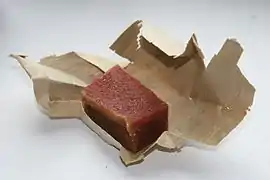Guava jelly
Guava jelly (Spanish: bocadillo (de guayaba), "guava snack"), or guava paste, is a Colombian confection made with guava pulp and panela, which is consumed abundantly throughout Colombia, one of the largest guava producers in the world. The town of Vélez, Santander Department, is a major centre of production for the sweet and gives it the alternative name "bocadillo Veleño".[1]
 A block of bocadillo sitting upon its dried leaf packaging. | |
| Alternative names | Bocadillo (de guayaba) |
|---|---|
| Type | Confectionery |
| Course | Snack |
| Place of origin | Colombia |
| Region or state | South America |
| Associated national cuisine | Colombia |
| Main ingredients | Guava pulp and panela |
In Venezuela, the form of consumption is similar to that of Colombia, where the product is called "conserva". In Venezuela, it can be of guava, coco, banana etc.
Bocadillo is commonly accompanied by cheese, spread upon bread,[2] or simply eaten on its own. It most often takes the form of a small rectangular block, with a firm consistency and a deep red colour, giving it a similar appearance to the related Spanish dessert dulce de membrillo.
Very similar to guava jelly dessert is the closely related Brazilian goiabada, also made from guava but with less sugar.
In 2006, the bocadillo veleño was nominated for the cultural symbol for Colombia in the contest organized by a magazine, Semana.[3]
Preparation
Bocadillo is prepared much like other conserves, jams, and jellies. The guavas are first washed and peeled before being mashed into a pulp, which is strained to remove seeds.
The pulp is then boiled in water along with panela or refined sugar at a low temperature for several hours until the mixture has a thick consistency. The liquid is left to cool off to make it be molded into blocks. It gets its characteristic firm texture once it is fully cooled.[1][4]
Bocadillo de guayaba is traditionally individually wrapped in the leaves of the bijao (calathea lutea) to preserve it and to enhance its flavour.
See also
- Quince cheese
- Hawthorn pudding
References
- Restrepo, Cecilia (October 2007). "El Bocadillo Veleño" (in Spanish).
- Bulletin. Bulletin. Florida Dept. of Agriculture. 1934. p. 27. Retrieved June 23, 2017.
- Revista Semana. "El bocadillo veleño". Retrieved 2011-03-24.
- "Bocadillos De Guayaba" (in Spanish). Archived from the original on 2013-08-15. Retrieved 2012-02-20.
Se prepara con 1/2 kilo de guayaba peladas y sin semillas, hervidas en una olla con agua hasta que queden disueltas. Luego se agrega 1 kilo de azúcar y se cocina a fuego alto, removiendo constantemente con una paleta durante 1 hora. Al estar pastosa la cocción se apaga el fuego y se vierte en una tabla o bandeja de aluminio. Se extiende con una cuchara mojada con agua y se espera hasta el siguiente día para cortarlo en trozos pequeños.
